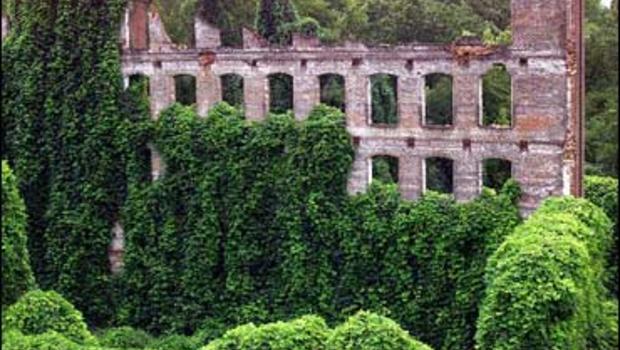
©http://ottersandsciencenews.blogspot.ca/. Unauthorized duplication of this blog's material is prohibited. Excerpts and links may be used, provided that full credit and link is given to Otters and Science News Blogspot. Link to this post: http://ottersandsciencenews.blogspot.ca/2015/12/kudzu-feared-invasive-plant-that.html - Thank you for visiting my blog.
~~~~~~~~~~~~~~~~~~~~~~~~~~~~~~~~~~~~~~
In the History Channel documentary series Life After People (for sale on DVD) there is a segment showing how in a world without people the Kudzu plant would rapidly take over large parts of the southern US destroying the native foliage and completely covering empty buildings and abandoned cars.
 The killer climbing plant eating the South: Mysterious Chinese Kudzu species has engulfed parts of Georgia, Alabama and South Carolina - and there's no way to stop it
The killer climbing plant eating the South: Mysterious Chinese Kudzu species has engulfed parts of Georgia, Alabama and South Carolina - and there's no way to stop it  |
| A North Carolina building |
Continue reading about Kudzu, see more images, and watch brief VIDEO
KUDZU FACTS
- Kudzu, also called Japanese Arrowroot, belongs to the legume family which is related to the pea
- A legume is a plant that produces its fruit in the form of a pod. A kudzu's pod blossoms into a tall, purple flower that has a grapelike fragrance.
- The catch is that only kudzu vines draped over other plants or objects can produce seed pods, because blossoms grow from those hanging vines.
- An entire cluster produces two or three healthy seeds, but they can germinate even after several years of dormancy
- The secret to the plant's durability is in the roots - they sprout new ones to reproduce very quickly.
- From there, these starch roots grow as deep as 12 feet (3.66 meters) and can weigh up to 300 pounds (136 kilograms).
- The plant was introduced to the U.S. at the Japanese pavilion in the 1876 Centennial Exposition in Philadelphia
- The plant climbs over trees or shrubs and grows so rapidly that it kills them by heavy shading
- It is seen along roadsides and other disturbed areas throughout most of the southeastern U.S.
- To try and control Kudzu you need to kill each of the rooted stems at their crowns. Mowing or cutting back the vegetation to the ground is the first step in removal before putting chemical herbicides on them but they won't disappear straight away. This can be a several-seasons battle.
*Source How Stuff Works
HOW TO IDENTIFY KUDZU
Look for trifoliate leaves, or formations with 3 leaflets attached at each node. All 3 leaves will be attached to the stem on their own petiole, or stalk. The central leaf's petiole will be about 3/4 inch (19 mm) long, while the 2 outer leaves have much shorter petioles.
Continue reading about how to identify Kudzu
Other sources for this article
http://www.nps.gov/plants/alien/fact/pumo1.htm
http://www.dailymail.co.uk/news/article-3374056/That-s-no-Christmas-tree-Nightmarish-photos-capture-world-s-invasive-plant-known-Kudzu-engulfs-destroys-natural-growth-way.html
https://en.wikipedia.org/wiki/Kudzu
http://www.personal.psu.edu/afr3/blogs/siowfa13/2013/10/overgrowth.html
http://earthsky.org/earth/to-embrace-or-not-to-embrace-non-native-species
Kudzu contributes to the production of OZONE
http://www.sciencedaily.com/releases/2010/05/100517172302.htm
http://www.cbsnews.com/news/kudzu-plant-source-of-ozone-pollution/
Watch 4 minute video of how Kudsu and other invasive plants would take over in Life After People - History Channel documentary.
CAUTION: There are images of creepy insects and bats that you may find disgusting.
*****************************************************






No comments:
Post a Comment
Thank you for visiting my blog. Your comments are always appreciated, but please do not include links.